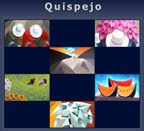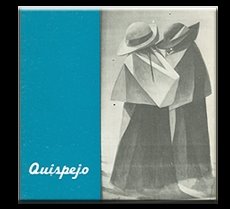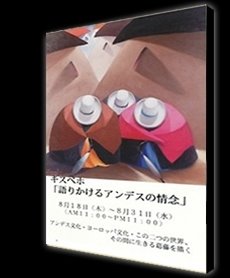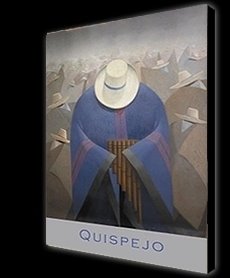An Andean Renaissance
The characters in his paintings are mostly brightly dressed Andean women wearing large hats. They toil at different tasks, such as picking flowers, white buds cottons, or bundles of wheat. All hide their faces from the viewer, beneath their hats or mantles, giving them an air of mystery, shyness, charm.
These enigmatic yet cheerful women are the creation of Jorge Quispe or “Quispejo,” the Andean artist who developed a new style of painting and who has undoubtedly become the country’s most imitated painter. Of course there is notorious difference between his work and those of his countless imitators, who sell their works in plazas and streets to many an unsuspecting buyer. But Quispejo also has many fans who recognize his sure strokes and unique mixing of colors and geometric shapes.
Quispejo is glad to have so many imitators. His dark face and features, normally fixed in an austere expression, lighten into a smile when he speaks of his imitators. “I never thought my style would be copied so often,” he says. “There are imitations made specially for tourists. They don’t bother me. Maybe I should even brag that it happens.”
Young painters who copy him sometimes apologize for doing so, Quispejo says. They also thank him for giving them a style that sells enough to feed their families.
Born in Marca, at the food of the Cordillera Negra, Quispejo reflects in his paintings the images of his childhood – the colorfully dressed peasants, the intensely blue skies, the ominous storm clouds, the fields of flowers whose colors bring the landscape alive.
Quispejo graduated en 1973 from the National Fine Arts School. He studied under Milner Cajahuaringa, already an established artist when he was teaching. Quispejo says he first experimented with the figurative style of his teacher and then moved on to develop Andean themes. He was initially concerned about painting Andean subjects because he thought art critics would accuse him of being too commercial.
With several exhibits around the world and paintings in private collections in Switzerland, Israel, and the US, Quispejo is proud of his style and ancestry which have allowed him to adorn his canvasses with images from his past.
Quispejo tries to accurately record his memories, and that is why he does not reveal the faces of his men and women. “Back then, people were evasive with strangers. Their custom, perhaps dating from the time their ancestors were slaves, was to be distrustful, fearful. When someone, spoke to them they lowered their heads, hiding their faces under the rim of their hats or mantles,” the artist says.
At, 46, Quispejo is at the height of his career. Late last year he exhibited his still life paintings, which contrasted with his usual Andean themes. He then participated with others artist in an important exhibit in Miami entitled “Rediscovering the Americas.” This exhibit contained works by painters from 21 countries in North, Central and South America and the showing proved such a success that a second one is being planned.
“I think the success of the show was due to the fact that Latin American painting is a new painting, full of youth and vitality. Throughout the world it is recognized as a pictorical style with specific characteristics. Some critics believe, and I think rightly so, that Latin American artist are the protagonist of a new worldwide Renaissance in painting.”
Looking ahead, Quispejo feels he still has much more to develop in his pictorical work and then he’d like to dedicate himself wholly to teaching.
“I think that those of us who have something to teach are under an obligation to do so. But in Peru, teaching is not a job, it’s a sacrifice,” says the artist.
Celinda Barreto F.
Source: Magazine The Lima Times. Lima, Perú. Vol. 19 #3. June 1994.
domingo, agosto 13, 2006
Suscribirse a:
Entradas (Atom)









